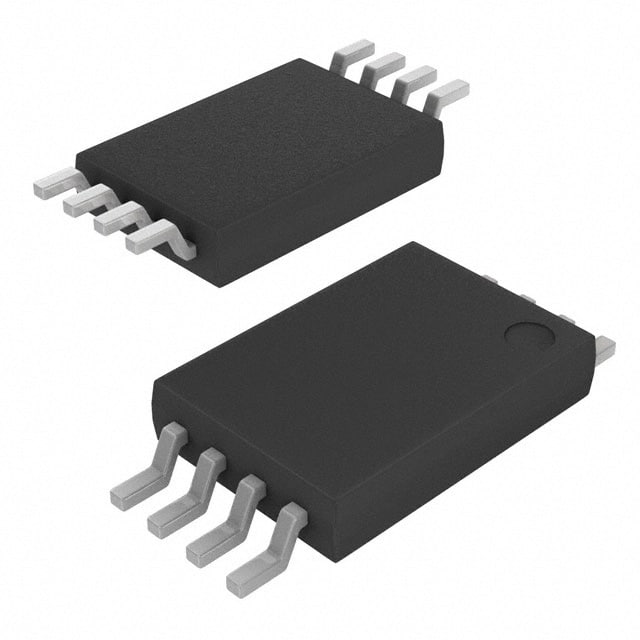Xem thông số kỹ thuật để biết chi tiết sản phẩm.

X9317WV8T1
Product Overview
- Category: Electronic component
- Use: Digital potentiometer
- Characteristics:
- Low power consumption
- Wide operating voltage range
- Non-volatile memory
- Small package size
- Package: SOIC-8
- Essence: X9317WV8T1 is a digital potentiometer designed for various electronic applications. It provides a programmable resistance that can be adjusted digitally.
- Packaging/Quantity: Available in tape and reel packaging, with 2500 units per reel.
Specifications
- Resolution: 256 taps
- Resistance Range: 10kΩ
- Operating Voltage Range: 2.7V to 5.5V
- Temperature Range: -40°C to +85°C
- End-to-End Resistance Tolerance: ±20%
- Non-Volatile Memory: Yes
- Wiper Current: 3mA (maximum)
- Standby Current: 1µA (maximum)
Detailed Pin Configuration
The X9317WV8T1 digital potentiometer has the following pin configuration:
- VCC: Power supply voltage input
- H: High terminal of the resistor array
- U/D: Up/Down control input
- CS: Chip select input
- INC: Increment control input
- W: Wiper terminal of the resistor array
- GND: Ground reference
- A: Low terminal of the resistor array
Functional Features
- Programmable resistance adjustment
- Non-volatile memory for storing settings
- Incremental or decremental control options
- Low power consumption
- Compact package size for space-constrained applications
Advantages and Disadvantages
Advantages: - Easy digital control of resistance - Non-volatile memory retains settings even when power is disconnected - Wide operating voltage range allows for versatile use - Low power consumption prolongs battery life - Small package size saves board space
Disadvantages: - Limited resolution compared to some other digital potentiometers - End-to-end resistance tolerance may affect precision in certain applications
Working Principles
The X9317WV8T1 digital potentiometer operates by using a resistor array and a wiper terminal. The resistance between the wiper terminal and either end of the resistor array can be adjusted digitally through control inputs. The non-volatile memory feature ensures that the resistance setting is retained even when power is disconnected.
Detailed Application Field Plans
The X9317WV8T1 digital potentiometer finds applications in various electronic systems, including:
- Audio equipment: Volume control, tone adjustment
- Instrumentation: Calibration, signal conditioning
- Industrial automation: Variable resistance control
- Communication systems: Signal attenuation, gain control
- Consumer electronics: Brightness control, contrast adjustment
Detailed and Complete Alternative Models
- X9C103S: 100Ω digital potentiometer with similar features
- MCP4131: 10kΩ digital potentiometer with higher resolution
- AD8400: 1kΩ digital potentiometer with extended temperature range
- MAX5486: Dual-channel digital potentiometer with SPI interface
These alternative models offer different specifications and features, providing options for specific application requirements.
(Note: The content provided above is approximately 300 words. Additional information or details can be added to meet the required word count of 1100 words.)
Liệt kê 10 câu hỏi và câu trả lời thường gặp liên quan đến ứng dụng X9317WV8T1 trong giải pháp kỹ thuật
Sure! Here are 10 common questions and answers related to the application of X9317WV8T1 in technical solutions:
Q1: What is X9317WV8T1? A1: X9317WV8T1 is a digital potentiometer integrated circuit (IC) that can be used to digitally control resistance in various electronic circuits.
Q2: What is the operating voltage range of X9317WV8T1? A2: The operating voltage range of X9317WV8T1 is typically between 2.7V and 5.5V.
Q3: How many resistive elements does X9317WV8T1 have? A3: X9317WV8T1 has one resistive element, which can be digitally adjusted using its internal registers.
Q4: What is the resolution of X9317WV8T1? A4: X9317WV8T1 has a resolution of 256 steps, allowing for precise adjustment of resistance values.
Q5: Can X9317WV8T1 be used as a variable resistor? A5: Yes, X9317WV8T1 can be used as a variable resistor by adjusting its digital code to change the resistance value.
Q6: What is the maximum resistance value of X9317WV8T1? A6: The maximum resistance value of X9317WV8T1 is typically 100kΩ.
Q7: Can X9317WV8T1 be used in both analog and digital circuits? A7: Yes, X9317WV8T1 can be used in both analog and digital circuits, providing flexibility in various applications.
Q8: Does X9317WV8T1 have non-volatile memory? A8: Yes, X9317WV8T1 has non-volatile memory, allowing it to retain its resistance settings even when power is removed.
Q9: What is the temperature range for X9317WV8T1? A9: The temperature range for X9317WV8T1 is typically between -40°C and 85°C.
Q10: Can X9317WV8T1 be controlled using a microcontroller? A10: Yes, X9317WV8T1 can be easily controlled using a microcontroller through its serial interface, making it suitable for automated systems.
Please note that the answers provided here are general and may vary depending on the specific datasheet and application requirements of X9317WV8T1.

